Posts posted by RomiK
-
-
On 5/11/2025 at 11:48 AM, Davide DB said: So, IMHO, HDR is a non-issue.
Here are a couple of links on that:
https://vmi.tv/blog/learn-help/hdr_reality_and_monitoring-a_dops_perspective/
If we accept the notion of being able to see what you get affects the artistic expression then it absolutely matters being able to see what you record in HDR if HDR is intended delivery. Only now I am beginning to understand that I am one of only a few which try to shoot and deliver in rec.2020 and I can tell you in these selected few light conditions where you don't see a thing in rec709 but do see beautiful scenes in 2020 renderings it absolutely matters to see what you get. Scenes which you would pass on in rec709 come to life with 2020 but if you can't see that it will limit your imagination.
-
-
To me it is a wasted opportunity and it is going to be a sales flop. I can't imagine a videographer excited about placing negative 0.86kg (like 2lb) (!!!) on top of their rig and plus having no option for LUT or at least some kind of generic HDR preview like Atomos offers. To me this launch is some kind of a partnership with scuba lamp or weefine kind of companies which launched similar brick products and they just mill out their own housing and their own version of a power source.
If I'd be a Nauticam I'd try to work with likes of Atomos to somewhat adjust their touch base UI to more centralized for use with fewer touch based contact point (after all we rarely adjust our monitors on the fly under water), take that product (Ninja or Shinobi) and run with it. Heck they could charge extra for that software version which is like clear profit...
Is there an emoji for frustrated...
-
To chime in
no need to use Enelopes - Ikea's Ladda 2450mAh work perfectly, priced at less than $10/4pc and did you know they are made in Japan? (do your own research re: NiMH quality based on factory locations)
I always transport and store Retra without batteries to prevent contacts spring board fatigue (see point 3) and also to make the carry on lighter if needed. I learned to use fanny pack for all my batteries (24AA for strobes - always charge spare 8 on liveaboards and change one strobe between dives if needed, then camera, lights and monitor batteries) and if I sense problem I just put these extra 2kg on my waist :-)
I had my fair share of issues with contact boards as my strobes (Retra Pro X with superchargers) experienced loss of power. I just couldn't swith them on. First I thought these were fatigued terminals and when I tried to spring them back off course I broke them - NEVER do this (!!). So I bought like 4 extra contact boards from Retra. But the issue could have been - all this time - oxidized contact pins inside of the main body. Because when I couldn't start the strobe last time I had quite fresh contact board so I thought this could not have been the issue - I checked the pins inside and sure enough one of them look not ok so I scratched it with flat screwdriver and voila - the strobe was starting again
@Oskar - Retra UWT - because we all use these strobes in oxidation happy environment and these pins inside are so difficult to reach would it be a good idea to come up with some sort of tool better then the flat scredriwer as the pins are rounded... Although if future strobes will be Lion acc powered it may not be an issue anymore.
-
5 hours ago, brightnight said:
Very interesting. I'm suprised to hear the the 28-60 is sharper than the 28-70, that's news to me! Now I'll have to dig in and do some reading.
Not sure if the 28-60 only applies to Sony or if it also applies to a canon DSLR like the 5D mkIV I'm using. Nowhere in the Canon 120 Port Chart do they mention the 28-60 and had I purposely picked the 28-70mm for the sharpness and very little for the zoom range since I'm almost never shooting at 70mm.
Oh nooo - 🫣 I thought you are Sony when mentioned 28-70 with WACP… canon’s 28-70 didn’t come up in my recollection of wacp chart… so I take it back as I know nothing about Canon’s 28-70
-
I would add before you do anything switch 28-70 for 28-60 and see results. If sharpness is the motivation 28-60 is sooo much sharper than 28-70. For wide-angle motivation obviously the choice is clear. I would use Sony TC2x as usability of zoom range in rivers and streams will far outweigh any minuscule feelings about quality. Having said that for ultimate quality I'd skip TC altogether as I am sensing in river and streams you want to bump into your subject anyway so I would leave 8-15 at 15 and just shoot those yellow perches out of the water 🙂. No TC 8-15 performance is stellar both in sharpness and micro contrast all the way from F4.
Another benefit from using 140mm I would appreciate in river and streams is the small size.
The drawback from 8-15 with 140 and especially TCs is that the rig will be a brick. A1 housing with 8-15 + metabones + TC2x and 140 is negative 1kg (!!) May not matter in rivers and streams though.
-
On 4/11/2025 at 10:50 AM, Johno1530 said:
You can get the bouyance collars for the Kraken and I'm just looking at the Retras with the booster attached and they are negative 150g each, so the 300g of the Kraken are not massively heavier.
The collars seem to fix the issue, I didn't see those before... pretty neat simple and slim
-
I think making strobes with negative 300g is a big design flaw and that by itself would be a big no for purchase. Unlike video lights where one can use total rig buoyancy and mass as stabilizer - assuming he never ever takes vertical video 😅 or macro - working with strobes require frequent repositioning with great "wingspan" and then with greatly negative endpoints the rig will fight even though it would be neutral as a whole. Sometimes it seems to me like the underwater photography gear would be designed by non photographers or people who don't dive 🤷♂️
-
Edited by RomiK
11 minutes ago, TimG said:As you say, RomiK, it’s all about personal preferences. I like the wreck image and, to me, it’s not so obviously a fisheye.
the chimney?... again, it's a personal preference I get it but in my view there is an artistic expression - intentional distortions - and documentary and educational value. Fisheyes in geometric world is all about expression and this is why we see it mainly on skateboard pics etc above water - hence the reason no mfg is rushing mirrorless versions of these. Just the underwater world seems to be stuck in those in part for technical in part for artistic and in part for trend setters... Just my 2c
-
Edited by RomiK
On 4/1/2025 at 11:10 PM, Byron said:I always take a fisheye and a longer macro (100, 105 or 90) as I think Egypt is great for fish portraits, especially Anthias and Tiger cardinal fish. The only trip I would also take a WACP on would be a deep south trip for the Oceanics, otherwise I am happy to leave it behind
Fisheye for the wrecks and reefs and longer macro for the Portraits
It's a personal preference for sure... For me I just don't understand why would anyone shoot wrecks intentionally distorted... To me this fisheye look on anything underwater is a bit of a farce.
-
I would probably ask Nauticam directly. Here you don't state enough information about your system... F or Z mount to begin with... the differentiator is the base unit and #1 #2 and #3 for FF eq. 90mm -120mm setups. Basically you need to measure the distance from the flat port glass to your lens in your setup and compare it with #1,2,3 options from the chart and lens combo and make decision. It will work, you just need to choose correct base unit.
-
-
After 6 months dentist induced diving coma I was back in the water at Cape Verde this week and what a joy it was to use Sony 20-70 F4 in 180mm glass dome I brought with me. I could have chosen WWL-1B or test 8-15/2x in 140mm instead . But I was never to Atlantic, didn’t know if I would shoot big or small, wanted to take photo and video so I chose to bring this combo which I call the solution ‘for unexpected’ (I also brought 16-35 F4 PZ but didn’t use it)
So to give you my take on your question - don’t sell your 14-30 and the dome just yet as it is the right tool for the some jobs. For example for Socorro’s mantas if you want both photos and videos. Fisheyes suck for video and WACPs and WWLs suck also as IBISes rely on lens focal length information which obviously get wrong by slapping these glorious adapted optics in front of native lenses.
Also one thing to consider is that with 8-15 and TC and adapters in 140glass your rig buoyancy will change dramatically so you will need to compensate for this. The photos below I took with 20-70.
-
Edited by RomiK
1 hour ago, fruehaufsteher2 said:Hi Romik,
again a new bunch of informations to consider. Good news: I already own the lens and it was really much cheaper and came in "like new" conditions. I own the 1,4 TC (usually use it with the 200-600 if 600 is not enough). The 2,0 TC could be around 300.- but all the other things count.
My personal experience with the long end of the 28-60 is better than yours... maybe quality varies...
A lot to think about befor hitting the "buy"-button.
Thanks a lot for all the input!
You're welcomed. Comp samples attached with annotation what is what. Details at 100%. As for 28-60 most reviews note the softness at 60 so my thinking is that it is what it is 🤷♂️
And real kicker is what to think of slapping €6500 FCP in front of 28-60 in long end 🙈. Then all of a sudden the €4500 or so for 8-15 TC2x begins to make sense for the quality overall 🤣
-
Edited by RomiK
1 hour ago, fruehaufsteher2 said:Hi Chris,
I already found out that the Sony TC doesn’t fit into the MC11. So I actually changed my mind and decided to go without TC.
My current perspective is to use the MC11 and the 140 dome from Nauticam.
I would encourage you to reconsider. In real world there is no difference between TC and non TC performance (minuscule on charts) and the flexibility of 16-30mm zoom is awesome. In fact and you'd be surprised the main strength of the use of 8-15 vs WACP or WWL1 is its long end.
At the short end the results are very comparable except for the angle of view and distortion (fisheye effect). And WACP has greater DOF at CFWA at comparable apertures. But at the long end 28-60 is quite soft and I could not believe what I saw after shooting test charts underwater. 8-15 at 30mm (both 140 and 180 domes) was a real treat compared to 28-60 WWL.
(P.S. @Adventurer - milimeters really don't matter and you need to get wet to find out 😉)
And then the money talk. The cost of it all. 1000 (lens used) + 500 (TC) + 500 (Metabones) + 650 (N100/120) + 800 (20+35extensions) + 1000 (the cheaper version of 140mm) + 300 (adapted zoom ring) and I will let you sum it up... Madness. Then 7.5k for FCP solution doesn't sound that bad 🙈😉
So from the other angle perhaps if one wants to tip toe into the world of fisheye and wants to spend close to 3000 for that maybe yes. But I think I bought for friend of mine an entire OMD OM-1 setup with excellent Oly 8mm1.8 and 140mm dome for that amount.
-
20 hours ago, Adventurer said:
Well, it depends what you define as "awful". 😉 This is usually a very subjective expression of the situation.
More objective would be:- miimeter distance of the entrance pupil
- milimeter distance of the port (required vs available extension rings)
- stronger image compression
- able to shoot the lens more oben (F4 or F8 instead of mandatory F11 or F16)
- priority on zoom flexibility
- priority on corner sharpness
- priority on avoiding chromatic aberrations
- priority on travel weight lightness
In physics and underwater photography there is usually no free lunch.
Meaning there is one death you have to die (as we say in German).
My approach will be to verify the theoretical moved position of the entrance pupil, with a paralax test on a nodal rail.
For that I do not need to go diving or get the system wet.
Again, thanks for sharing your results @RomiK !
However, I think there are combinations that will perform much better considering IQ in your rig.
I hope you will also be able to benefit from the findings in this thread.
All good points save for one I would disagree with. You absolutely have to get the system wet (not yourself necessarily 🙂 - I shoot my pictures laying on edge of my home pool shooting down 😉) in order to test as there are things coming to play like refraction and virtual image. The cutting mat is the best water resistant test bed I have found :-). I did try to play with Petzval surface phenomenon but didn't have that much patience to have meaningful result in case you'd like to really dive in 😁. Cheers
-
Edited by RomiK
11 hours ago, Adventurer said:Thanks @RomiK for posting the examples. For correct optical performance you have to get the dome size and positioning exactly right on a millimeter level.
You are introducing quite a bunch of variables by changing dome size and TC at once.
Knowing that Nauticam and Marelux 180mm domes are not full spheres your test was destined to fail. The 180mm dome with conical rear part was simply not made for that lens. The Canon 8-15 FE without the TC is very likely to perform better behind the 140mm dome, which is (almost) full sphere and suitable for fisheye lenses.
These were just a few of tests of different configurations I made... gave you those which I thought would be the most polarized in order to deliver the point - millimeters really don't matter, there are other things in play and we only need to be in a ballpark figure. Like 30mm vs 35mm extension? No real difference. Like 180mm sharper (minus the CA) than 140mm with Sony TC in ideal position? OMG the 180mm was supposed to be awful wasn't it? And Kenko was even worse🙈 than Sony. But you would have to spend time shooting charts underwater to understand this. Unfortunately the Internet is full of theories with "demonstrative" pictures from Raja Ampat 😂 which tend to muddy the waters somewhat. So I had to make my own tests. Good luck and I am looking forward to your UW test charts and conclusions 🙂
-
Edited by RomiK
13 hours ago, Adventurer said:I will be utilizing 2.0x and 1.4x Teleconverters with a fisheye zoom lens behind a dome.
I'd say it's either-or scenario. You'd need different port extension for each of them
13 hours ago, Adventurer said:
Currently doing the math for optimum dome positioning and sizing.I am under the assumption that the entrance pupil will move by adding a TC.
And I mean by that, not equivalent to the 31mm physicial space that the teleconverter adds between camera and lens.
Can you share your thoughts and maybe even the math for this endeavor?
I'd say the approach might be less scientific - basically push the lens back as far as not to get vignette at widest setting. The dome size is far more important than some millimeters in positioning. Down below left is 140mm glass dome with TC2x and lens at 8mm (=16mm) and correct position and right is 180mm dome with lens at 15mm (no TC) so far back that it already vignetted. Still the CA (see the blue lines) is so much more pronounced even though the right image scenario is sharper even in corners (but there is another variable like the lens was at 15mm and not 8mm and it didn't have TC on it).
I have no real life samples as to what effect this extreme CA would have on the real image underwater.
-
Edited by RomiK
I like the camera, the sound, the editing. I don't like the colors. It seems like desaturated and hue shifted a bit unnatural even where video lights were used. I know it's extremely difficult to unify color tone throughout the movie but I just don't like the look of this. Which camera and software?
-
12 hours ago, Grm said:
I’ve been to both and certainly thought currents were worse in Malpelo than Galapagos but that may just be timings, when I was in the Galapagos they frowned on using strobes as it tended to scare the sharks so I ditched them and just shot ambient light which minimised drag a lot. Only used strobes on bat fish / sea lion dives, iguanas are only 2-4 metres so no need for strobes there especially as there can be quite a bit of surge as you are so shallow
Typically most dives at Wolf/Darwin were only 20 metres and above which helps with light?
Ambient video with CWB for sure, sharks hate video lights and they don't come close anyway, but if you want to get that wall picture you've got to use strobes. Plus hammers don't mind the strobes as much as they mind divers 🙂. The advice is to stay away from other divers, don't breath when one is coming and then pop and shoot. The ambush!🤣
-
With experiences you have don't worry about Galapagos. Just keep the same habits you already have under your skin, nothing worse than complicate things with new stuff and then miss that whale shark swimming by over at Darwin arch... The most important thing will be your gloves and familiarity operating your rig with them. You will use your gloves to hold on to rocks at the current situations, tie downs are not being used at Galapagos as often you are perpendicular to the current so they aren't practical like at channel Maldives dives for example. Darwin and Wolf are all rocks no corrals so the way it goes is if there is bigger current you wedge yourself in between rocks, free up your hands and start operating the camera. My rig is same as yours and at times I had to minimize its profile and drag it behind me but that's nothing extraordinary. Basically all dives were one handed where my right hand never let camera go and left was used to manipulate my body. And then when wedged I was ready to ambush hammerheads 😂. The currents over there are no mask rippers, yes they may be stronger sometimes but no mask rippers... Darwin and Wolf are simple but the iguanas dive over at Fernandina could be a real washing machine so watch out 🤣 . Enjoy that beautiful place!
-
19 hours ago, Chris Ross said:
The Sony TC is 7mm longer than the Kenko 1.4x which 20mm thick, so this means the zoom gear needs to be 7mm longer. It's probably possible to adapt the design of the adapter ring used for the Canon 8-15 on m43 developed by Wolfgang and use it with the Nauticam zoom gear for the 8-15 plus 1.4x. If I recall correctly that one moved the zoom gear back by 5mm, so only needs a minor design adjustment. The Nauticam zoom gear for 8-15 plus 1.4x is 19538.
Otherwise the other thread on the 2x plus 8-15 mentioned a zoom gear printed by our member Gudge.
Thanks for heads up. In the meantime I bought Metabones V which does accept Sony TC 2x which I already had and is shorter than Kenko (40mm vs 27mm).
Then I had to decide on the zoom ring. The problem in adapting Nauticams Kenko version is that it utilizes focus knob on the 100-120 adapter which then creates problem when quickly removing camera from housing for battery change and pictures review.
So I utilized my existing Nauticam’s zoom ring for 20-70 and adapted it for now using 75mm waste piping system as shown on my prototype pictures. Works flawlessly, the union is rock solid and so I can pull out the camera quickly in between the dives. Later on I will design some kind of 3D printed extension for this solution as I want Nauticams aluminium barrel with cogs and not plastic 3D printed one.
I am ordering 140mm dome as it is clear to me that due to curvature I would always have CA problem with 180mm dome.
All in all I am beginning to think that I am building nice, travel friendly and versatile system around Sony N100
N100/120 + 20mm + 180mm for 16-35 PZ F4
N100/120 + 35mm + 180mm for 20-70 F4
N100/120 + 20mm + 35mm + 140mm for 8-15 F4 adapted as 16-30 F8 Fisheye (think travel friendly FCP1 🙂
N100 + macro port for 90mm and EMWL
WWL1 will probably go.
I will wait for 140mm to arrive and publish some tests and comparisons afterwards. Cheers.
-
Edited by RomiK
Thanks for the reaction, I've spent quite some time reading yours and @DreiFish posts recently 🥵.
I have both Sony and Kenko 2x - unfortunately neither Tokina or MC11 accept Sony 2x so I couldn't compare. I am not impressed with Sony 2x neither with 70-200 F4 GII or 200-600 so I think they will be same, the performance penalty is there but unless zoomed in 300% on 50Mp file one can't really notice it seems.
I am more concerned with CA when using 180mm dome and would like to see uncorrected 140mm samples with contrast subjects. I didn't see any CA with 140mm dome but I did see CA with 17inch dome at @DreiFish thread which made me wonder...
I wonder whether I could get satisfactory performance from 180mm dome and 8-15 w/2x to have one dome when traveling. I am quite OK with corner sharpness and micro contrast which in my opinion quite a bit surpasses that of WWL1 28-60 combo but that CA makes me wonder.
-
As part of my quest to determine viability of adapting 8-15 on my Sony A1 I made a series of shots which I thought could be of interest. I would also appreciate if current owners of this setup could answer certain concerns as far as chromatic aberration .
Testing setup was Sony A1 + Tokina TA-019 + (Kenko Teleplus HDpro 2x) + Canon 8-15 F4 taking picture of improvised lens resolution chart setup under simple LED light. Magnifications are 300% on a 50MPix sensor with ISO of around 2000 but you can see this on screenshots. White rectangle in left corner thumbnail shows magnified position.
First image the full view. 15mm is at 15 without tele, 16mm is at 8mm with 2x tele
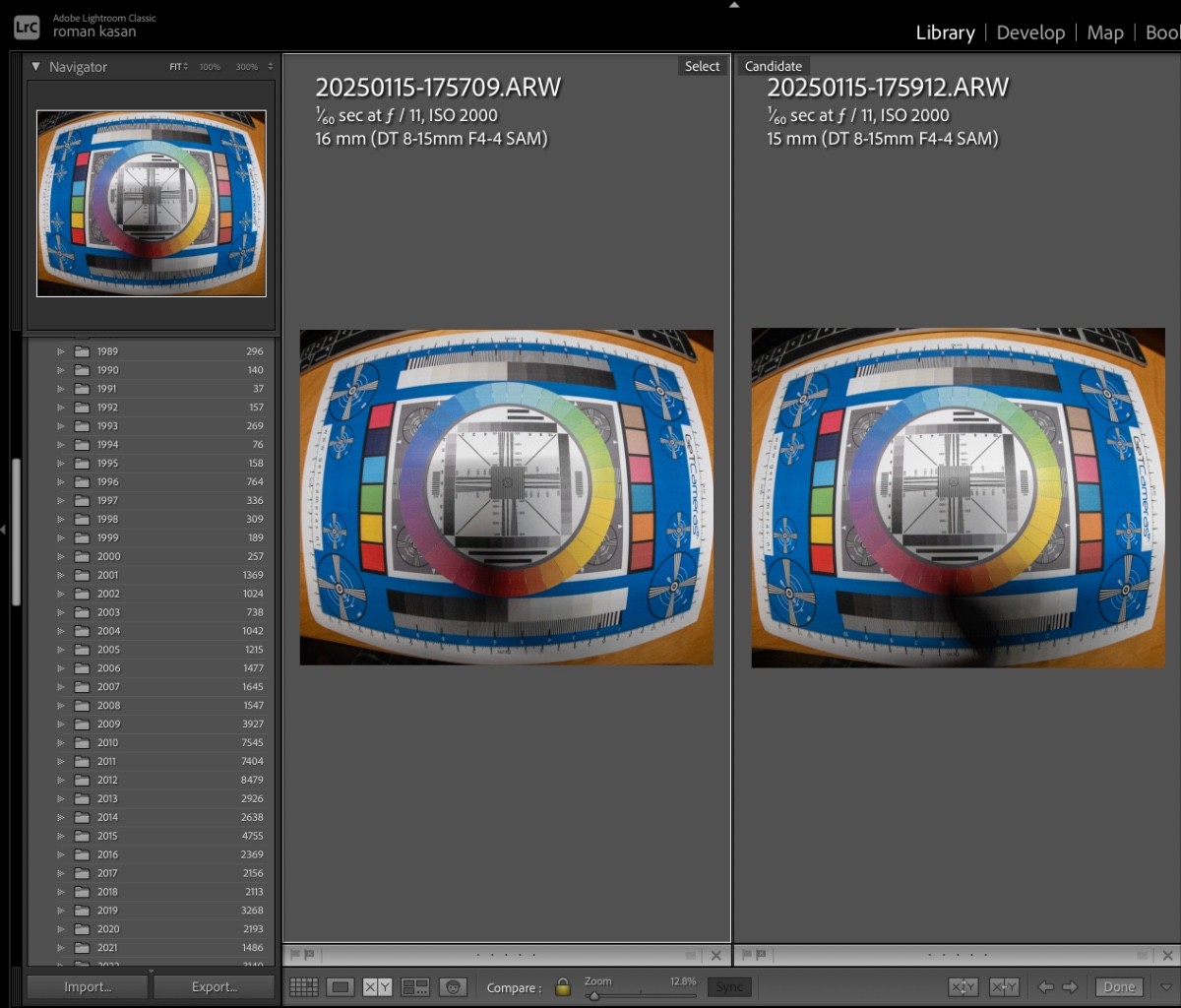
zoomed in 300%
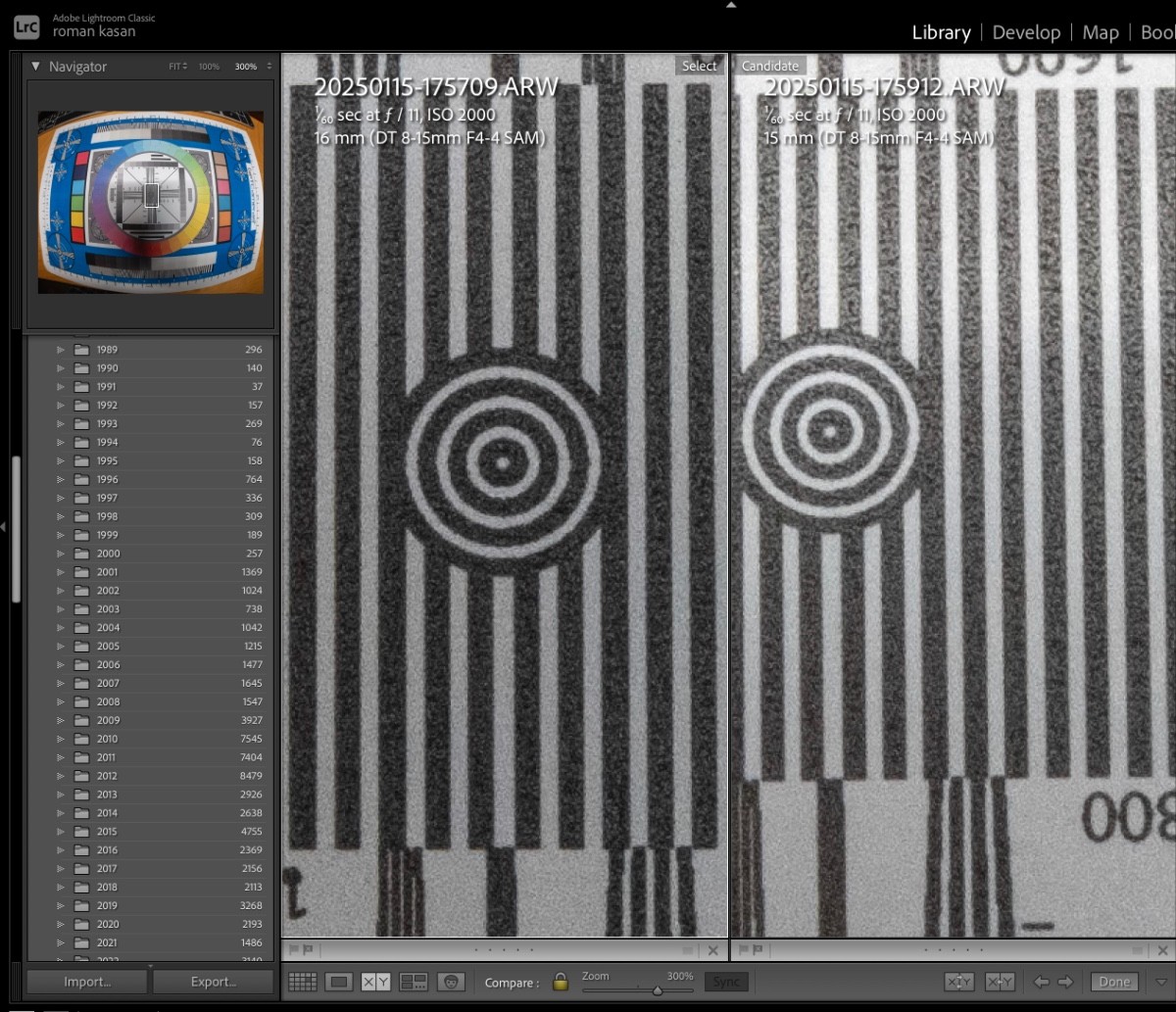
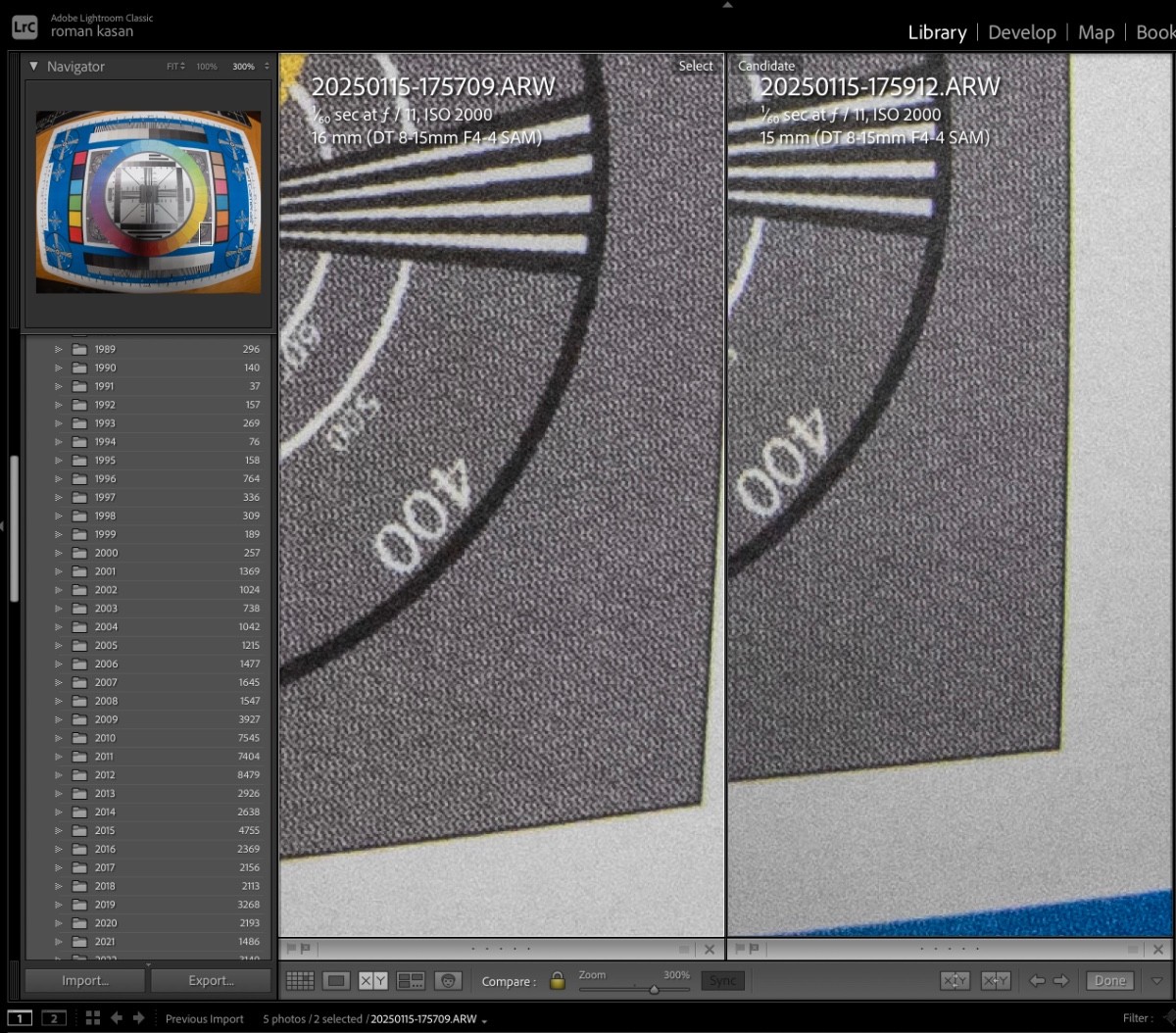
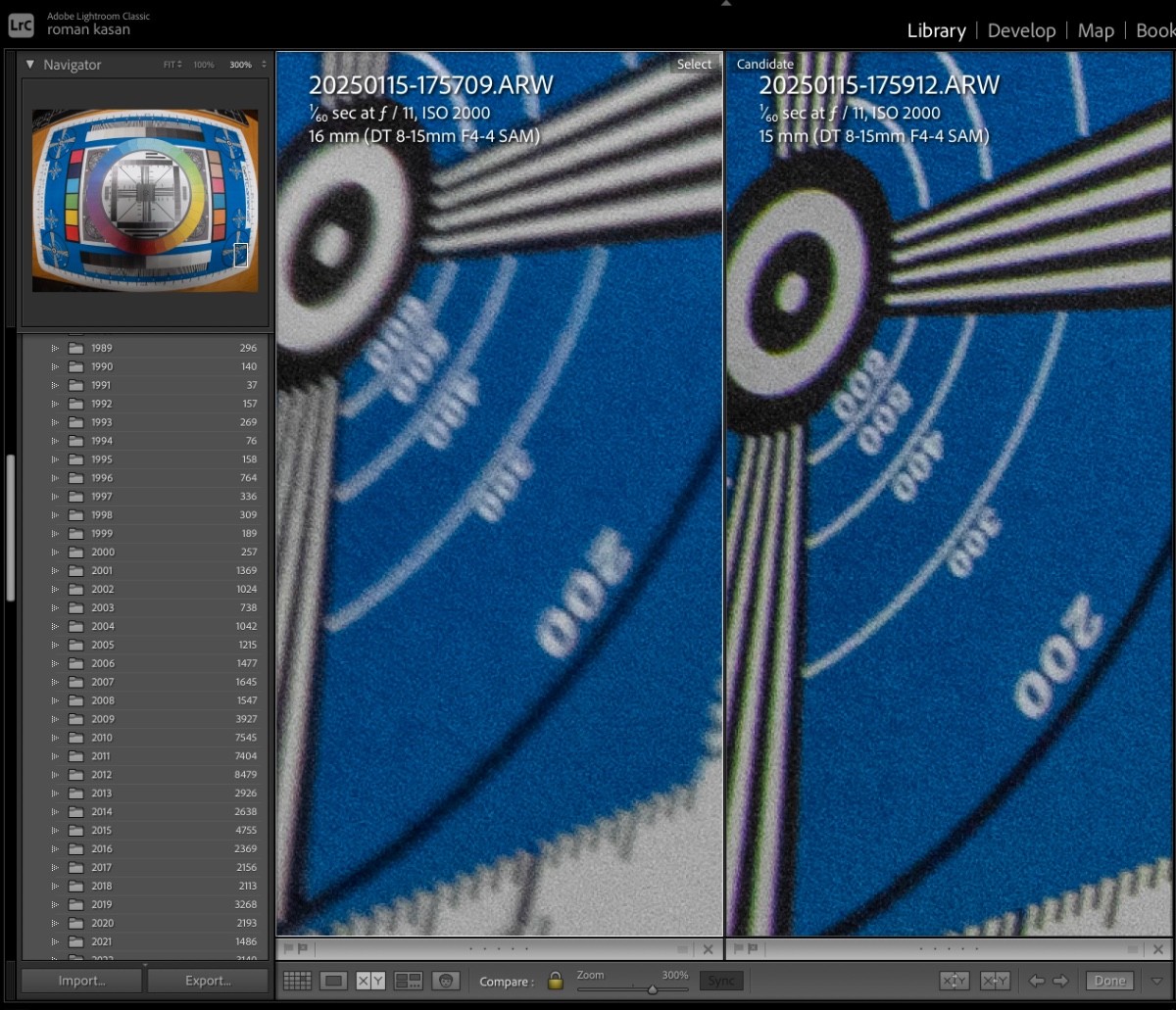
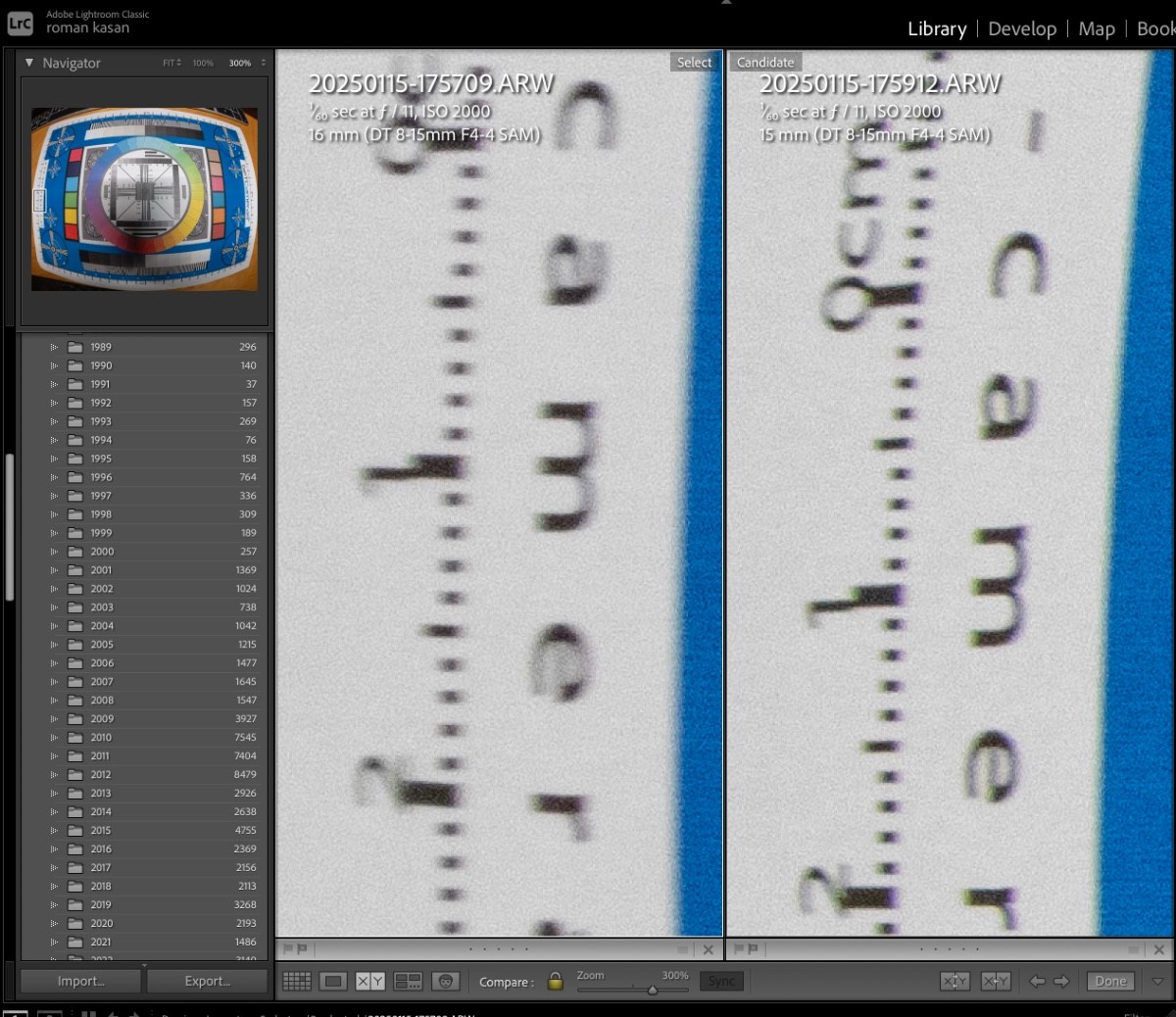
Underwater images without teleconverter at 15mm behind 180mm glass dome with 20mm port extension - too short (would need 15mm for this test, without the extension the CA was even worse in other pictures) but good for test and also a show a problem with chromatic aberration.
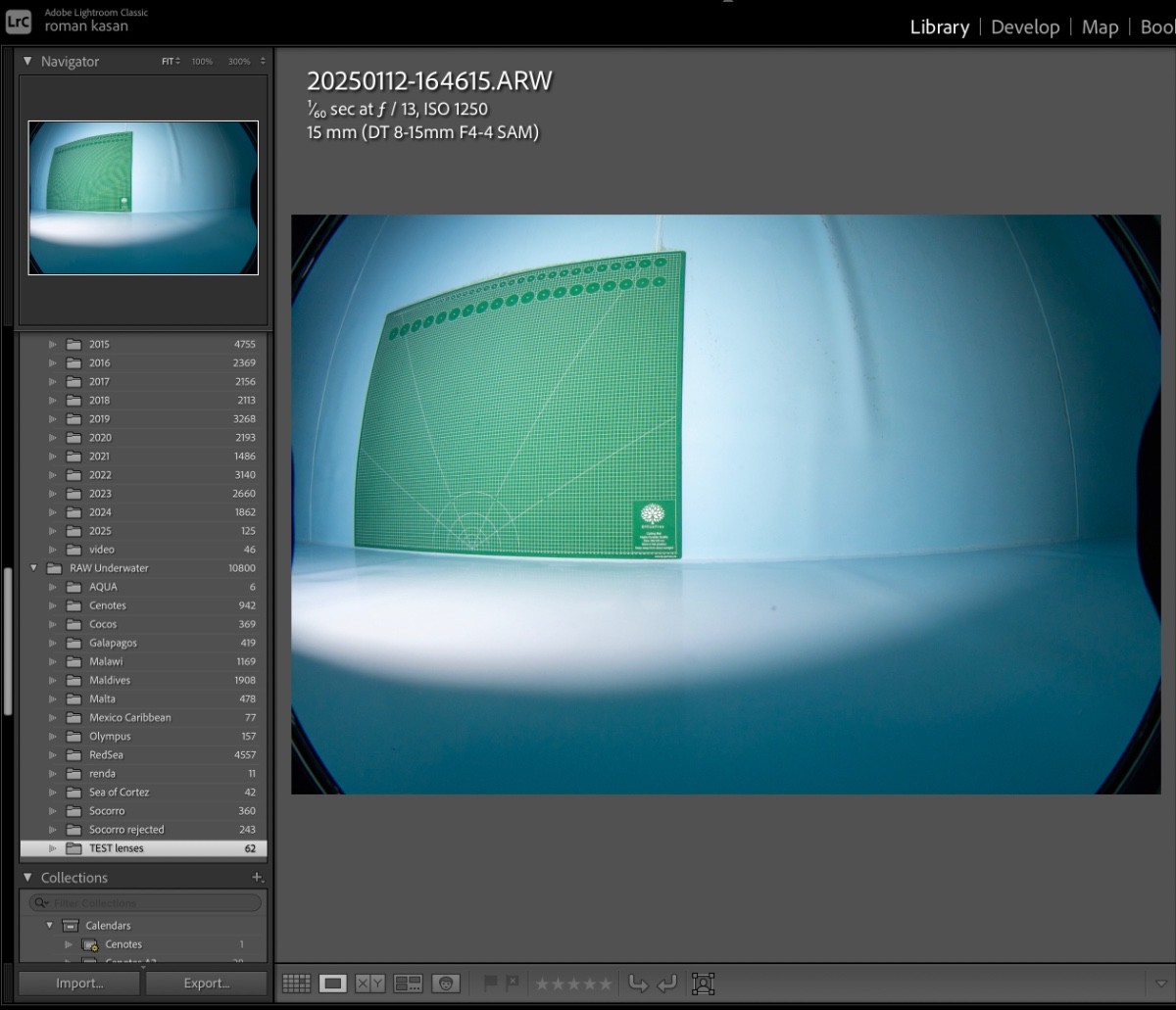
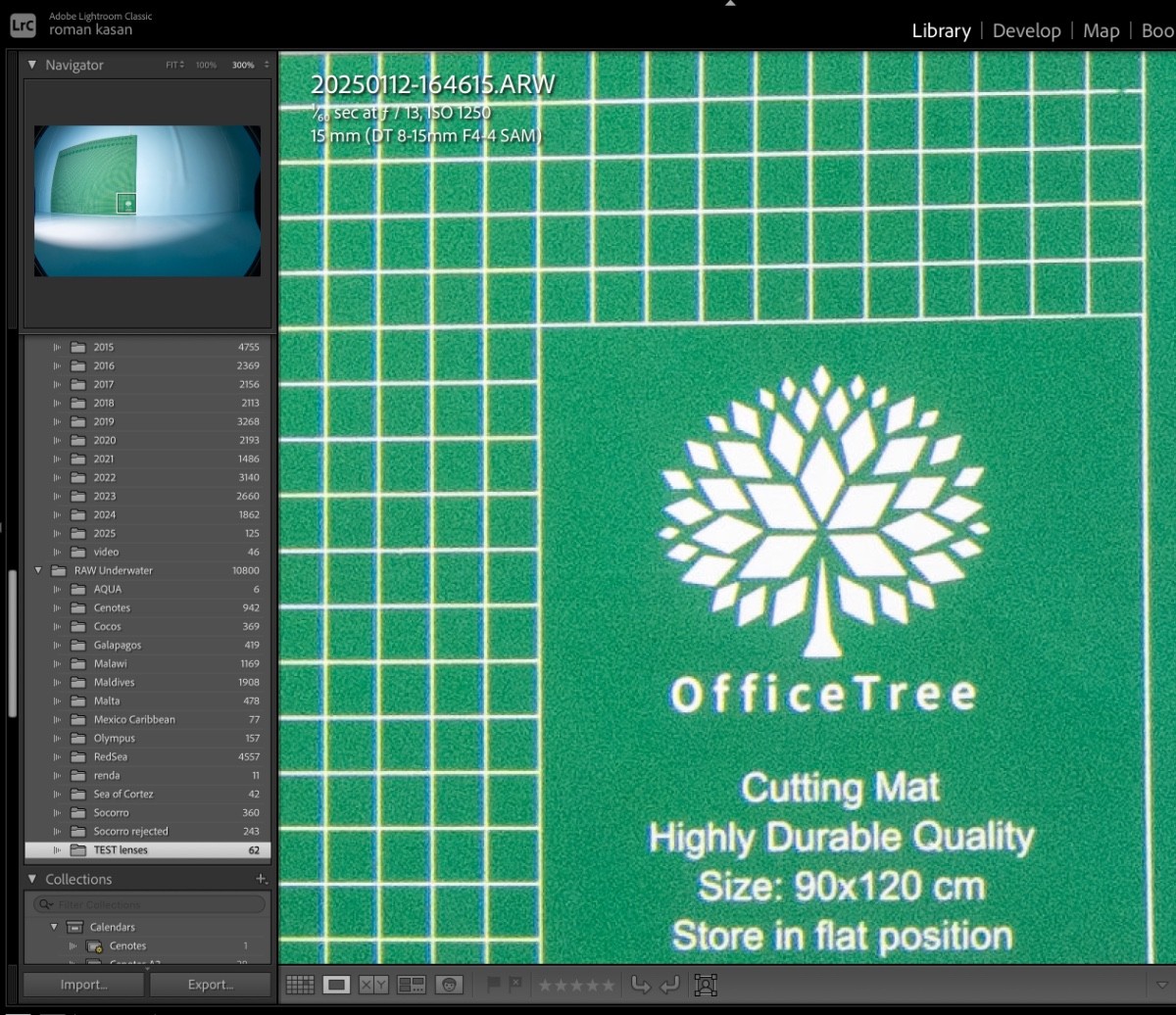
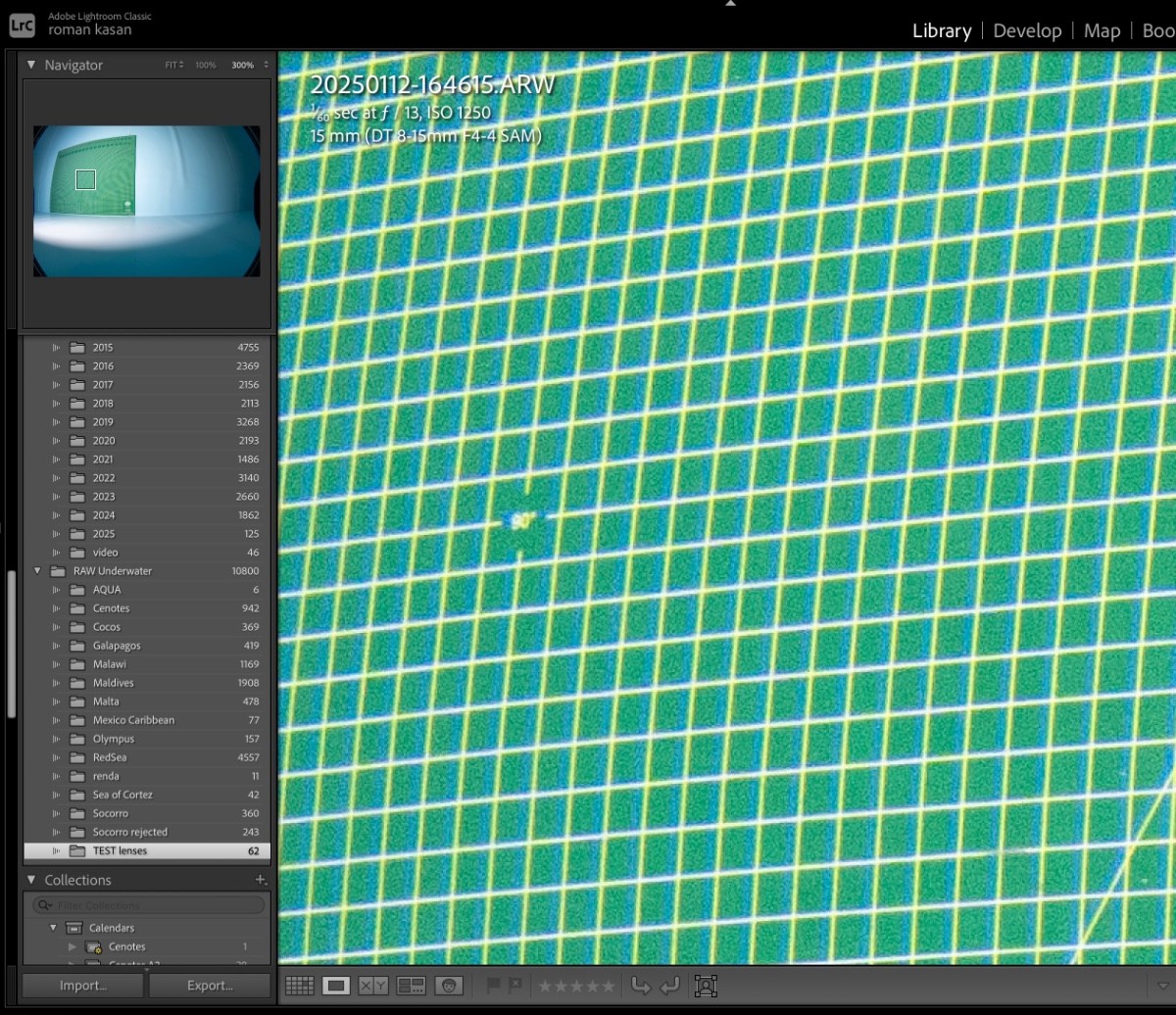
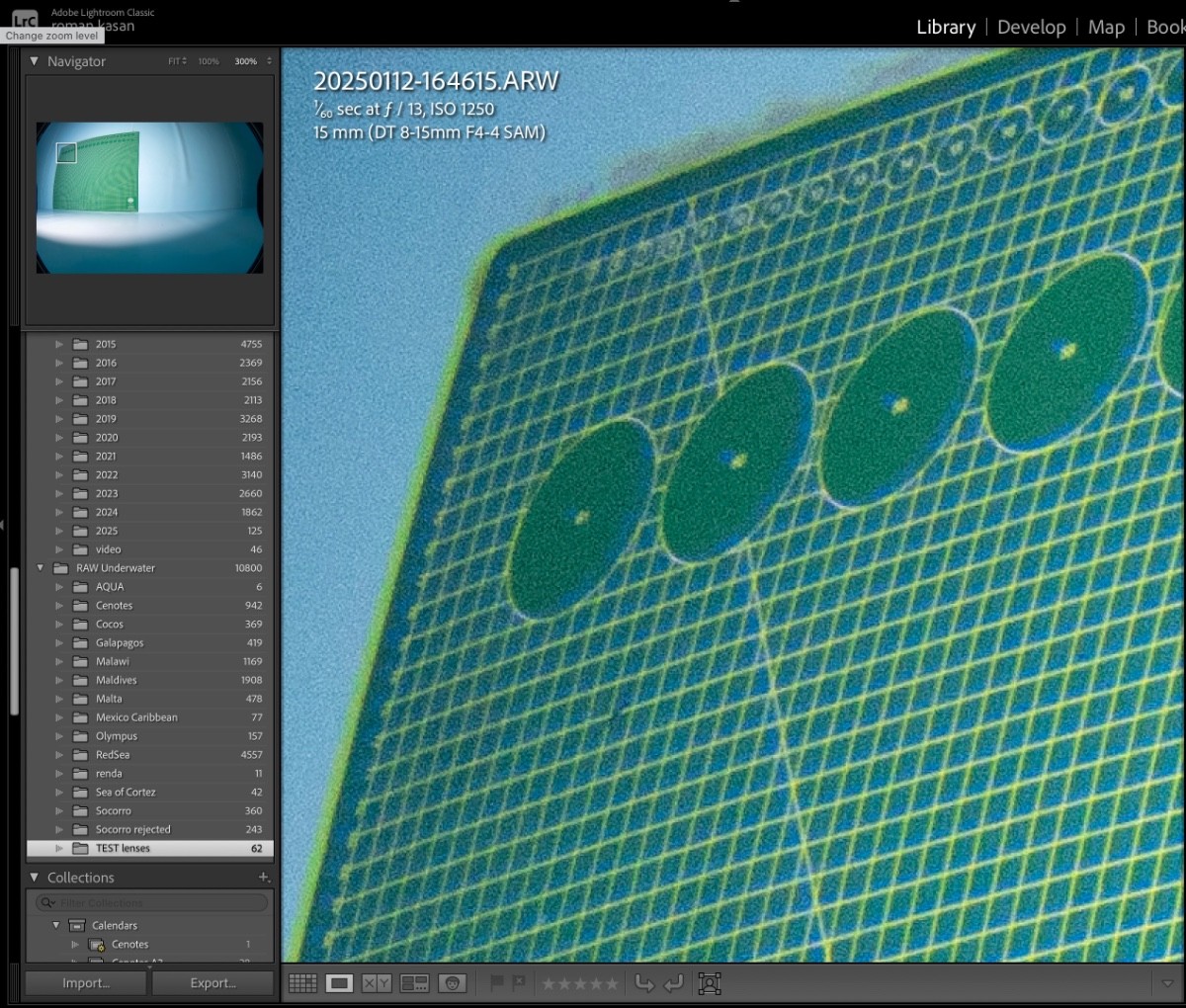
What I would like to see if any users of 8-15 have any sort of test images with 140mm dome and proper extension which could demonstrate chromatic aberration issue or lack of it. With 180mm glass the CA is absent only at the very center and starts showing quickly towards the corners.
Other then CA I am happy with corners and off center sharpness and resolution and micro contrast of adapted 8-15. Much better then WWL and perhaps WACPs, also Kenko 2x show no degradation of image whatsoever including color rendition so I think if I could tackle CA or it would show no issue in post the 8-15 with 2xKenko is great combo even for 50Mpix sensor adapted on A1. Tokina AF works flawlessly in photo mode including tracking and animal AF, also good in video mode that that has to be selected topside.




Nauticam new UW monitor - yay or nay... (rant)
in Video Gear and Technique
IDK if it helps but my experience with blackout on Sony A1 and Shinobi - it was there had resolution set to Auto or 4k30 in camera HDMI settings. When I set the HDMI settings to 1080p60 there was no blackout when switching modes anymore. Apparently camera is negotiating with monitor for the best resolution for given mode. When it doesn't negotiate there is no blackout and 1080p60 works well for both photo and video - no need to have 4k when monitor is 1080p anyway... BUT IDK weefine internals so...